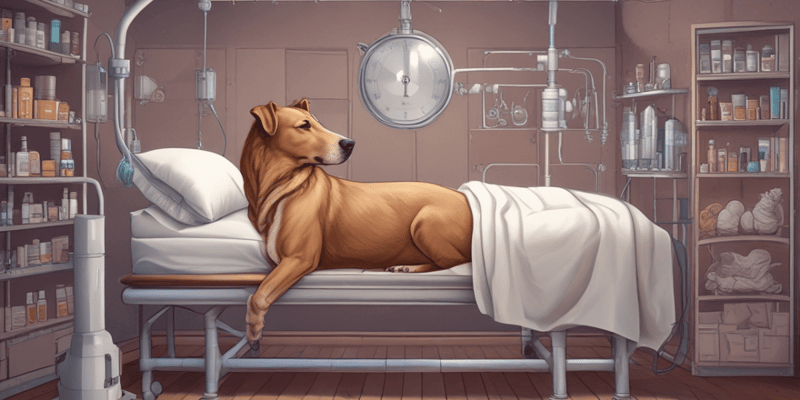17 Questions
What is the primary cause of airway obstruction during sedation or anesthesia?
Tongue falling back
A patient with which of the following conditions is more likely to have a difficult airway?
All of the above
What is the primary goal of basic airway management?
Support ventilation
How is the correct size of an oropharyngeal airway (OPA) determined?
Measure from incisors to angle of mandible
What is the primary benefit of properly placing an oropharyngeal airway (OPA)?
Displacing the tongue from the posterior pharynx
What is the name of the airway maneuver that involves tilting the head, lifting the chin, and thrusting the jaw?
Triple airway maneuver
What is the primary purpose of a Bag Valve Mask Device?
To maintain a patent airway
What is the recommended administration instructions for Aspirin 81mg in a dental office emergency?
Chew four tablets and then swallow
What is the purpose of the airway maneuver when using a Bag Valve Mask Device?
To open the airway and facilitate ventilation
What is the minimum liter per minute capacity of the oxygen regulator?
15 liters per minute
What is the purpose of the Automated External Defibrillator (AED) in a dental office emergency?
To restore a normal heartbeat
What is the recommended administration instructions for Albuterol Inhaler in a dental office emergency?
Shake well and hold can vertically
What is the primary concern when a patient is experiencing a seizure in the dental office?
Protecting the patient from physical contact with objects in the operatory
What should be administered to a patient experiencing an allergic reaction with signs of breathing problems?
EpiPen and 100% Oxygen
What is the recommended position for a patient experiencing asthma or bronchospasm in the dental office?
Semi-reclined or upright position
What should be done if a patient is experiencing an allergic reaction with hives or rash, but no signs of breathing problems?
Observe the patient and prepare for basic life support
What should be done if a patient is experiencing an allergic reaction with rapidly occurring hives or rash?
Administer Benadryl 50mg IM and stat page
Study Notes
Airway Management
- Call for help early, tackle critical problems first, and prioritize supporting ventilation and circulation.
- Airway obstruction is the most common emergency associated with sedation/anesthesia, leading to serious neurological and cardiovascular events.
Anatomy of Airway Obstruction
- A patent airway consists of a soft palate, tongue, epiglottis, and trachea.
- A blocked airway can be caused by the tongue, epiglottis, or other obstructions.
Predicting a Difficult Airway
- Factors that predict a difficult airway include:
- Class II skeletal malocclusion
- Short neck
- Obese patient
- Macroglossia
- Limited range of motion (LROM) cervical neck
- LROM temporomandibular joint (TMJ)
- History of sleep apnea
Airway Obstruction Symptoms
- "Rocking boat" breathing
- Supra-sternal retraction
Basic Airway Management
- Head-tilt chin-lift maneuver
- Jaw-thrust maneuver
- Triple airway maneuver (head-tilt, chin-lift, and jaw-thrust)
Oropharyngeal Airways (OPA)
- Use the correct size of OPA, measured from the incisors to the angle of the mandible.
- OPA placement can relieve physical obstruction by displacing the tongue from the posterior pharynx.
Emergency Equipment
- Oxygen tank with a regulator capable of variable flow up to 15 liters per minute
- Positive pressure breathing device
- Pocket mask
- Automated external defibrillator (AED)
- Blood pressure and stethoscope
- Emergency medications (e.g., aspirin, asthma inhaler, diphenhydramine, epinephrine, glucose paste, midazolam)
Emergency Medications
- Aspirin 81mg (chewable tablet) for acute coronary syndrome, chest pains, angina, suspected myocardial infarction (MI), or "heart attack"
- Asthma inhaler (albuterol) for acute asthmatic bronchospasm
- Diphenhydramine (Benadryl) for allergic reactions and anaphylaxis
- Epinephrine (1:1000) for severe allergic reactions and anaphylaxis
- Glucose paste for hypoglycemia
- Midazolam (Versed) for sedation and anxiety
Emergency Response
- Follow the instructions for administration of each medication
- Use 100% oxygen for asthma and bronchospasm
- Administer EpiPen for severe allergic reactions and anaphylaxis
- Protect the patient from physical contact and maintain a patent airway during seizures
Test your knowledge on airway obstruction, its anatomy, and predicting difficult airways. Learn about the importance of ventilation and circulation in emergency situations.
Make Your Own Quizzes and Flashcards
Convert your notes into interactive study material.
Get started for free



